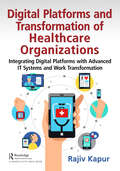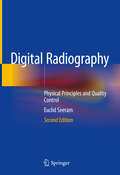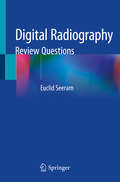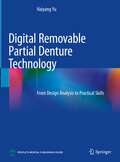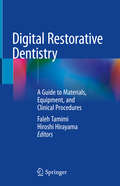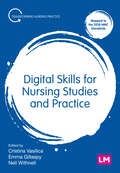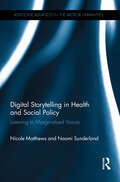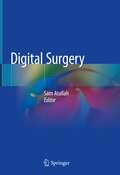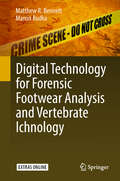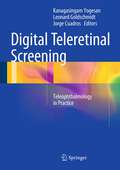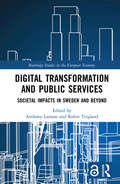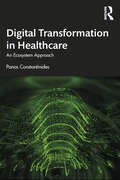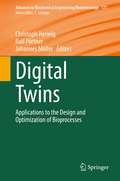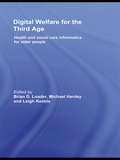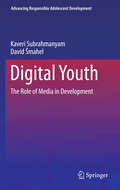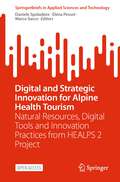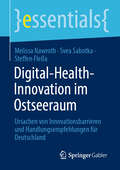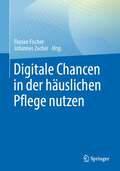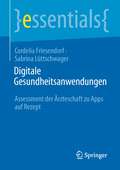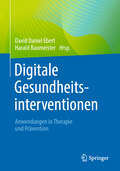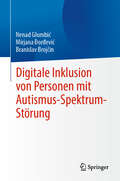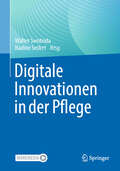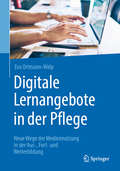- Table View
- List View
Digital Platforms and Transformation of Healthcare Organizations: Integrating Digital Platforms with Advanced IT Systems and Work Transformation
by Rajiv KapurCOVID-19 accelerated healthcare’s transition towards digital technology since it helped expand the capacity of healthcare organizations (HCOs) through extended patient access and isolation. In addition to HCOs, this transition was adopted by other participants in the healthcare ecosystem, such as independent digital health platform (DHP) vendors, self-insured employers, drug chains/pharmacy benefit managers, and insurance companies. It was not long before independent DHPs, payers, and self-insured employers realized the value of digital technology, so they increased their commitment towards this transition. The goal of this book is to help HCOs understand, prepare, implement, and leverage digital transformation. The book opines that, to be successful, digital transformation must be led and supported by senior management. Equally important is the cultural transformation of HCOs towards successful change management, which requires an evolutionary approach to continuous process improvements of increasing scope and complexity. Next, HCOs must generate a comprehensive digital transformation roadmap that aligns with their strategic plan for enhancing clinical and related capabilities while improving patient engagement. To accomplish their digital transformation, HCO management and key stakeholders must comprehend and meet prerequisite requirements for: digital health platforms, advanced information technology, and work transformation methodologies. DHPs, and associated hardware and software complements, form the foundation of digital health technologies prevalent in modern-day healthcare and have gained increasing importance since COVID-19. Advanced information technology includes concepts vital to healthcare transformation such as EHRs, interoperability, big data, artificial intelligence, natural language processing, data security, and privacy. Lastly, work transformation methodologies address work redesign that incorporates different levels of process improvements and phases of digital transformation, lean/six sigma, agile methodologies, and human factors engineering to ensure well-designed interfaces for care providers and patients. The overarching goal of this book is to provide a roadmap for US healthcare towards an organized digital transformation which will lead to improved outcomes, reduced costs, and improved patient satisfaction.
Digital Radiography: Physical Principles and Quality Control
by Euclid SeeramThis is the second edition of a well-received book that enriches the understanding of radiographers and radiologic technologists across the globe, and is designed to meet the needs of courses (units) on radiographic imaging equipment, procedures, production, and exposure. The book also serves as a supplement for courses that address digital imaging techniques, such as radiologic physics, radiographic equipment and quality control. In a broader sense, the purpose of the book is to meet readers’ needs in connection with the change from film-based imaging to film-less or digital imaging; today, all radiographic imaging worldwide is based on digital imaging technologies. The book covers a wide range of topics to address the needs of members of various professional radiologic technology associations, such as the American Society of Radiologic Technologists, the Canadian Association of Medical Radiation Technologists, the College of Radiographers in the UK, and the Australian and New Zealand Societies for Radiographers.
Digital Radiography: Review Questions
by Euclid SeeramThis book serves as a supplement to the book ‘Digital Radiography: Physical Principles and Quality Control, 2nd Edition (ISBN 978-981-13-3243-2)’ published by Springer Nature in 2019. This book includes review questions of multiple choices, true/false and short answer formats based on the chapters of the already published book along with their answers. It includes questions that mimic the nature of the questions in certification examinations of professional radiologic technologist organizations, such as the American Association of Radiological Technologists (ASRT) and the Canadian Association of Medical Radiation Technologists (CAMRT) and other certification organizations in the United Kingdom and Australia. The book includes 10-15 review questions on each of the essential topics covering the scope of digital radiography (DR), such as definition of DR, limitations of film-screen radiography, digital image processing concepts, physics and technology of computed radiography (CR), flat-panel digital radiography (FPDR), image quality descriptors including artifacts for CR and FPDR, the standardized exposure indicator, the technical aspects of digital fluoroscopy, digital mammography, digital tomosynthesis, picture archiving and communication systems (PACS), imaging informatics, quality control for DR, and radiation dose optimization in DR. The book is relevant for diagnostic radiography students, diagnostic radiology residents (MDs), radiology practitioners and biomedical engineering technologists all over the world.
Digital Removable Partial Denture Technology: From Design Analysis to Practical Skills
by Haiyang YuThis book introduces esthetic clasp as an innovative method that improves the appearance of clasps by changing the clasp design. It details the concept of esthetic clasp, the classification of esthetic clasp design methods, the clinical pathway of esthetic clasp techniques, many selected cases, and the logos of different kinds of esthetic clasps. This book is suitable for all professional dentists, dental technicians and students.
Digital Restorative Dentistry: A Guide to Materials, Equipment, and Clinical Procedures
by Faleh Tamimi Hiroshi HirayamaThis book offers up-to-date, readily understandable guidance on the materials and equipment employed in digital restorative dentistry and on the specific clinical procedures that may be performed using the new technologies. The key components of digital restorative dentistry – image acquisition, prosthetic/restorative design, and fabrication – are fully addressed. Readers will find helpful information on scanners, the software for prosthetic design, and the materials and technologies for prosthesis fabrication, including laser sintering, 3D printing, CAD/CAM, and laser ablation. The section on clinical procedures explains all aspects of the use of digital technologies in the treatment of patients requiring removable partial dentures, complete dentures, fixed partial prostheses, crowns, endodontics, and implant surgery and prosthodontics. The field of restorative and prosthetic dentistry is undergoing rapid transition as these new technologies come to play an increasingly central role in everyday dental practice. In bridging the knowledge gap that this technological revolution has created in the field of dentistry, the book will satisfy the needs of both dentists and dental students.
Digital Skills for Nursing Studies and Practice (Transforming Nursing Practice Series)
by Neil Withnell Cristina M. Vasilica Emma GillaspyThis practical book equips you with the digital capabilities you need for your nursing studies and career. Whether you are a digital native or less confident with technology, the book develops your ability to harness digital tools and opportunities to enhance your nursing practice. From using technology for better communication, collaboration and participation to honing your technical skills, the book instils the digital mindset you need as a 21st century nurse. Key features: · Mapped to HEE’s Digital Capability Framework · Structured around opportunities for self-assessment and reflection to help you identify the areas that require work · Focuses on the capabilities specifically needed for the nursing role, using activities and case studies to highlight their application to practice · Covers topical issues such as digital wellbeing, online professionalism, data protection and more
Digital Skills for Nursing Studies and Practice (Transforming Nursing Practice Series)
by Neil Withnell Cristina M. Vasilica Emma GillaspyThis practical book equips you with the digital capabilities you need for your nursing studies and career. Whether you are a digital native or less confident with technology, the book develops your ability to harness digital tools and opportunities to enhance your nursing practice. From using technology for better communication, collaboration and participation to honing your technical skills, the book instils the digital mindset you need as a 21st century nurse. Key features: · Mapped to HEE’s Digital Capability Framework · Structured around opportunities for self-assessment and reflection to help you identify the areas that require work · Focuses on the capabilities specifically needed for the nursing role, using activities and case studies to highlight their application to practice · Covers topical issues such as digital wellbeing, online professionalism, data protection and more
Digital Storytelling in Health and Social Policy: Listening to Marginalised Voices (Routledge Advances in the Medical Humanities)
by Naomi Sunderland Nicole MatthewsAs digital life stories continue to assume more and more significance across a range of institutions, so too does their potential to bring into focus once marginalised and neglected voices. Breaking new ground by reframing multimedia life stories as a resource for education, public health, and policy, this book challenges policymakers, professionals, and researchers to reimagine how they find out about and respond to people’s daily lives and experiences of health, disability, and well-being. The book develops theoretical, methodological, and practical resources for listening to digital stories through a series of carefully selected international case studies, from dementia care education to campaigns in the UN to ban cluster munitions. The case studies explore and illuminate different ways that digital stories have – and have not – been listened to in the past. The authors expose the great potential as well as the complexity of using powerful personal stories in practice. Together, the case studies highlight that processes of listening to, learning from, and making use of digital stories involve unavoidable processes of reinterpretation, recontextualisation, and translation which have significant ethical and political implications for storytellers, listeners, and society. In mapping and theorising the movement of stories into new contexts of policy and practice, the book offers a critical lens on the widely celebrated democratising potential of digital storytelling and its capacity to amplify marginalised voices. Digital Storytelling in Health and Social Policy develops an authoritative and original re-conceptualisation of digital life stories and their use for social justice ends, and will be important reading for researchers and practitioners from a range of backgrounds, including social policy, digital media, communication, education, disability, and public health.
Digital Surgery
by Sam AtallahThis book provides a trove of insightful perspectives on the current state and the realization of digital surgery. Digital surgery entails the application of artificial intelligence and machine learning toward automation in robotic-assisted surgery. More generally, the objective is to digitally define the patient, the surgical field, and the surgical problem or task at hand; to operate based on information, rather than based on anatomic planes alone. But digital surgery has shapeshifted into other, equally intriguing faces – many of which are exemplified by topics throughout this book. Digital surgery is fundamental to 3D-printed organs, mind-controlled limbs, image-guided navigation, and tele-mentoring. It is the key that unlocks the metaphorical doorway to surgical access, thereby creating a global framework for surgical training, education, planning, and much more. This text provides methods of measurement and perception outside of the human umwelt – including the ability to visualize fields beyond the visible light spectrum, via near infrared fluorescent organic dyes which are rapidly being bioengineered to target specific tumors, as well as native anatomic structures of interest. Written by experts in the field, Digital Surgery is designed to help surgeons operate with an enriched understanding of an individual’s specific attributes: including the human phenome, physiome, microbiome, genome, and epigenome. It also aids surgeons in harnessing the power and fluidity of the cloud, which is emerging as a significant resource for surgeons both regionally and globally.
Digital Technologies in Craniomaxillofacial Surgery
by Alex M. GreenbergDigital technologies are changing the way that surgeons operate. They are revolutionizing the ability of surgeons to visualize, plan, and create rapid prototyped models and patient- specific implants for the broad disciplines of ENT, plastic, oral and maxillofacial surgeons. This book provides information on the latest digital technologies available for craniomaxillofacial surgery, discussing how this technology allows for preplanned procedures with improved and superior outcomes. Rather than improvise during surgery, surgery and its procedures can be preconceptualized with superior outcomes and decreased patient morbidity.
Digital Technology for Forensic Footwear Analysis and Vertebrate Ichnology
by Matthew R. Bennett Marcin Budka“There is no branch of detective science which is so important and so much neglected as the art of tracing footsteps. Happily, I have always laid great stress upon it, and much practice has made it second nature to me.” Sherlock Holmes, Study of Scarlet.Despite the fictional nature of Sherlock Holmes this statement rings true today. The study of footwear is neglected in modern forensic practice and does have much to offer. What it needs is an injection of technology and modern analytical tools. These tools are emerging from the digital revolution currently transforming vertebrate ichnology. Ichnology is the discipline of earth science which focuses on the study of trace fossils such as footprints. This book draws upon both disciplines - geology (ichnology) and forensic science - to show how the two have much to learn from each other especially with regard to the digital capture and analysis of footprints. This book presents field and laboratory methods associated with the collection, analysis and presentation of three-dimensional tracks (footprints) whether from a crime scene or a geological/archaeological excavation. It shows students, researchers and practitioners how to collect and analyse 3D data and take advantage of the digital revolution transforming ichnology. This book is not only essential reading for forensic and earth science students but also for professional forensic practitioners as well as for applied computer scientists developing new tools for visualization and analysis of 3D data. The book forms a natural methods focused complement to the successful text Fossilised Locomotion published by Springer 2014.
Digital Teleretinal Screening
by Kanagasingam Yogesan Leonard Goldschmidt Jorge CuadrosDigital retinal imaging performed by primary care providers and nurses, followed by remote image interpretation (teleretinal imaging), is rapidly acquiring a crucial role in many parts of the world as it permits the detection of major diseases, such as diabetic retinopathy and glaucoma, in patients who would otherwise be beyond the reach of a trained ophthalmologist. In this book, experts from around the world describe how digital teleretinal screening can be set up and optimally utilized. Technical issues are discussed, and the appropriate use of screening for different diseases and in different age groups is explained. The major part of the book draws upon the clinical experience of leading practitioners in a wide range of teleretinal applications. The result is a comprehensive source of high-quality information for clinicians and other health professionals who are involved in eye care delivery, so that they can assess how teleretinal screening might be applied to their working practice.
Digital Transformation and Public Services: Societal Impacts in Sweden and Beyond (Routledge Studies in the European Economy)
by Robin Teigland Anthony LarssonThrough a series of studies, the overarching aim of this book is to investigate if and how the digitalization/digital transformation process affects various welfare services provided by the public sector, and the ensuing implications thereof. Ultimately, this book seeks to understand if it is conceivable for digital advancement to result in the creation of private/non-governmental alternatives to welfare services, possibly in a manner that transcends national boundaries. This study also investigates the possible ramifications of technological development for the public sector and the Western welfare society at large. This book takes its point of departure from the 2016 Organization for Economic Co-operation and Development (OECD) report that targets specific public service areas in which government needs to adopt new strategies not to fall behind. Specifically, this report emphasizes the focus on digitalization of health care/social care, education, and protection services, including the use of assistive technologies referred to as "digital welfare." Hence, this book explores the factors potentially leading to whether state actors could be overrun by other non-governmental actors, disrupting the current status quo of welfare services. The book seeks to provide an innovative, enriching, and controversial take on society at large and how various aspects of the public sector can be, and are, affected by the ongoing digitalization process in a way that is not covered by extant literature on the market. This book takes its point of departure in Sweden given the fact that Sweden is one of the most digitalized countries in Europe, according to the Digital Economy and Society Index (DESI), making it a pertinent research case. However, as digitalization transcends national borders, large parts of the subject matter take on an international angle. This includes cases from several other countries around Europe as well as the United States.
Digital Transformation in Healthcare: An Ecosystem Approach
by Panos ConstantinidesIn an era of digital transformation within healthcare management, this important book outlines an ecosystem perspective to illustrate how a range of actors can use digital technologies to offer better value within the provision of healthcare services. From mobile applications to point-of-care diagnostic devices, from AI-enabled applications for data analysis to cloud models for service delivery and blockchain infrastructures, it provides a roadmap for how healthcare organizations can leverage these digital technologies. The book is also illustrated with case studies from different areas, including software for medical diagnostics, blockchain infrastructures for use in pharmaceutical supply chains and clinical trials, and federated learning platforms for genomics. Covering key issues such as patients’ rights to data and written in the aftermath of the COVID-19 pandemic, the book will be essential reading for researchers, postgraduate students, and professionals interested in how technology can support and enable healthcare service provision.
Digital Twins: Applications to the Design and Optimization of Bioprocesses (Advances in Biochemical Engineering/Biotechnology #177)
by Ralf Pörtner Christoph Herwig Johannes MllerThis is the second of two volumes that together provide an overview of the latest advances in the generation and application of digital twins in bioprocess design and optimization. Both processes have undergone significant changes over the past few decades, moving from data-driven approaches into the 21st-century digitalization of the bioprocess industry. Moreover, the high demand for biotechnological products calls for efficient methods during research and development, as well as during tech transfer and routine manufacturing. In this regard, one promising tool is the use of digital twins, which offer a virtual representation of the bioprocess. They reflect the mechanistics of the biological system and the interactions between process parameters, key performance indicators and product quality attributes in the form of a mathematical process model. Furthermore, digital twins allow us to use computer-aided methods to gain an improved process understanding, to test and plan novel bioprocesses, and to efficiently monitor them. This book focuses on the application of digital twins in various contexts, e.g. computer-aided experimental design, seed train prediction, and lifeline analysis. Covering fundamentals as well as applications, the two volumes offers the ideal introduction to the topic for researchers in academy and industry alike.
Digital Welfare for the Third Age: Health and social care informatics for older people
by Brian D. Loader Michael Hardey Leigh KeebleThis book is about the ways digital technology can contribute to the welfare of older people. The Internet, mobile phones and other technologies have changed how we live and work. Such technologies also shape how services for older people are organised in ways that potentially place carers and older people at the centre of service provision. Telecare can make homes ‘smart’ so that they are more comfortable and less risky for people who can take advantage of devices that help make them independent members of their community. Digital Welfare is part of the broader project in Britain and elsewhere to adopt new information and communications technologies (ICTs) to organise and deliver health and social welfare services. This includes mundane technologies like an alarm to call for help to complex telecare ‘smart homes’ and electronic patient records. The intended and unintended consequences of such new technologies must be explored if we are to benefit from these innovations. Based on recent research this book seeks to highlight and examine the new opportunities and dilemmas that confront older people and all those concerned with their welfare in the network society. This edited collection provides original contributions from leading academics and researchers in the field to access the evidence for improved professional integration and user-centred health and social care services for older people arising from health informatics. Digital Welfare for the Third Age will be of interest to all those working with older people.
Digital Youth
by Kaveri Subrahmanyam David SmahelYouth around the world are fittingly described as digital natives because of their comfort and skill with technological hardware and content. Recent studies indicate that an overwhelming majority of children and teenagers use the Internet, cell phones, and other mobile devices. Equipped with familiarity and unprecedented access, it is no wonder that adolescents consume, create, and share copious amounts of content. But is there a cost? Digital Youth: The Role of Media in Development recognizes the important role of digital tools in the lives of teenagers and presents both the risks and benefits of these new interactive technologies. From social networking to instant messaging to text messaging, the authors create an informative and relevant guidebook that goes beyond description to include developmental theory and implications. Also woven throughout the book is an international sensitivity and understanding that clarifies how, despite the widespread popularity of digital communication, technology use varies between groups globally. Other specific topics addressed include: Sexuality on the Internet.Online identity and self-presentation.Morality, ethics, and civic engagement.Technology and health.Violence, cyberbullying, and victimization.Excessive Internet use and addictive behavior. This comprehensive volume is a must-have reference for researchers, clinicians, and graduate students across such disciplines as developmental/clinical child/school psychology, social psychology, media psychology, medical and allied health professions, education, and social work.
Digital and Strategic Innovation for Alpine Health Tourism: Natural Resources, Digital Tools and Innovation Practices from HEALPS 2 Project (SpringerBriefs in Applied Sciences and Technology)
by Marco Sacco Daniele Spoladore Elena PessotThis open access book presents a set of practical tools and collaborative solutions in multi-disciplinary settings to foster the Alpine Space health tourism industry’s innovation and competitiveness. The proposed solutions emerge as the result of the synergy among health, environment, tourism, digital, policy and strategy professionals. The approach underlines the pivotal role of a sustainable and ecomedical use of Alpine natural resources for health tourism destinations, and highlights the need of integrating aspects of natural resources’ healing effects, a shared knowledge of Alpine assets through digital solutions, and frames strategic approaches for the long-term development of the sector. The volume exploits the results of the three-years long EU research project HEALPS 2, which involved several stakeholders from the health tourism, healthcare and sustainable tourism industries. This book is relevant for health tourism destinations and facilities (hotels, clinics, wellness and spa companies), regional and local authorities (policy makers), business support organizations, researchers involved in digital healthcare and geoinformatics.
Digital-Health-Innovation im Ostseeraum: Ursachen von Innovationsbarrieren und Handlungsempfehlungen für Deutschland (essentials)
by Steffen Fleßa Melissa Nawroth Svea SabotkaDigital Health hat bereits in viele Länder Einzug gehalten, unterscheidet sich jedoch in Umsetzung, Entwicklung und Durchdringung. Dänemark, Schweden, Finnland, Norwegen und Estland zeigen sich in vergleichenden Ranglisten weit oben, Deutschland im unteren Mittelfeld. Dieses Buch analysiert, basierend auf einer Literaturrecherche und einem interdisziplinären Forschungs-Workshop, welche Faktoren die unterschiedliche Diffusion der Digital-Health-Innovation bedingen, welche Vorteile die genannten Länder gegenüber Deutschland haben und welche Veränderungen in bestehenden Strukturen notwendig sind, um aufzuholen. Bestehende Barrieren für eine zeitgemäße, digital gestützte Gesundheitsversorgung können überwunden werden – hierfür braucht Deutschland Champions, die Digital Health zu ihrer Herzensangelegenheit machen.
Digitale Chancen in der häuslichen Pflege nutzen
by Florian Fischer Johannes ZacherDigitale Chancen in der häuslichen Pflege nutzen! Dieses Buch richtet sich an Personen und Institutionen, die an der häuslichen Pflege älterer Menschen beteiligt sind und alle, die sich mit der Digitalisierung im Bereich von Gesundheit und Pflege beschäftigen. Digitale Technologien bieten nachhaltige Lösungen für vielfältige Herausforderungen in der häuslichen Versorgung. Davon können Pflegende und Pflegebedürftige in der Zukunft profitieren. Eine hohe Versorgungsqualität, Entlastung und mehr Selbstbestimmung im häuslichen Umfeld sind Ziele, die durch digitale Technologien unterstützt werden. Die Autor:innen zeigen Möglichkeiten und geben zentrale Handlungsempfehlungen für den Einsatz und die Weiterentwicklung von digitalen Lösungen. Sie stellen außerdem dar, welche Bedingungen für eine gelingende Implementierung in die Praxis zu beachten sind.
Digitale Gesundheitsanwendungen: Assessment der Ärzteschaft zu Apps auf Rezept (essentials)
by Cordelia Friesendorf Sabrina LüttschwagerDigitale Gesundheitsanwendungen (Apps auf Rezept) sind Medizinprodukte, die auf Technologien basieren. Das Digitale-Versorgung-Gesetz lässt die Verschreibung digitaler Lösungen zu. Somit will Deutschland in digitaler Versorgung Vorreiter sein. Gelingt dieser Erfolg? Wie betrachten die Akteure die Digitalisierung? Auf welche Pain Points müssen Ärzte, Versicherungen und Start-ups achten? Cordelia Friesendorf und Sabrina Lüttschwager bereiten die Praktiker im Gesundheitswesen mit dem aktuellsten Know-how vor, den Branchenerfolg zu gestalten.
Digitale Gesundheitsinterventionen: Anwendungen in Therapie und Prävention
by Harald Baumeister David Daniel EbertDie Aufklärung von Patienten erfolgt mittlerweile selbstverständlich unter Nutzung des Internets. Auch Behandlungen und Beratungen sind zunehmend online möglich. Dieses Buch zeigt die Möglichkeiten digitaler Gesundheitsinterventionen bei psychischen Störungen wie z.B. Angst- und Suchtstörungen, Demenz sowie bei körperlichen Erkrankungen wie Diabetes mellitus, Tumor- und Schmerzerkrankungen. Ein weiterer Schwerpunkt liegt im Einsatz bei Gesundheits- und Risikoverhaltensweisen, wie Stressmanagement, Raucherentwöhnung oder Ernährung. Es zeigt wie Notebook, Smartphone und Wearable genutzt werden können, wie sie wirken und wo sie eingesetzt werden können, z.B. in der Prävention, der betrieblichen Gesundheitsförderung, der Akutversorgung oder der Rehabilitation. Das Werk wendet sich an alle Ärzte, Psychotherapeuten und Psychologen, die moderne Medien zur Behandlung ihrer Patienten einsetzen und die Prinzipien verstehen möchten.
Digitale Inklusion von Personen mit Autismus-Spektrum-Störung
by Nenad Glumbić Mirjana Đorđević Branislav BrojčinDieses Buch untersucht Chancen und Hindernisse für die digitale Inklusion von Personen mit Autismus-Spektrum-Störung (ASS). Es behandelt die grundlegenden Anforderungen der „digitalen Gesellschaft“ sowie Konzepte der digitalen Inklusion (und Exklusion), der digitalen Teilhabe und der digitalen Kluft bei Behinderungen und bietet Unterstützung für Personen mit Autismus bei der Mitgestaltung digitaler Geräte. Das Buch diskutiert die Anwendung digitaler Technologien in verschiedenen Kontexten, einschließlich Bildung, Freizeitaktivitäten, Gemeinschaftsleben, alltäglichen Lebensfähigkeiten und Beschäftigung von Personen mit Autismus. Behandelte Bereiche umfassen: Computerbasierte Interventionen zur Sprachentwicklung, sozialen Kommunikation, exekutiven Funktionen und anderen Fähigkeiten bei Kindern mit Autismus. Digitale Gesundheitsinterventionen für Personen mit ASS. Risiken für Personen mit ASS im Internet (z.B. übermäßige Nutzung, süchtiges Verhalten und Cybermobbing). Nutzung digitaler Technologien zur Simulation von Vorstellungsgesprächen und zur Vermittlung von Arbeitsfähigkeiten. Nutzung digitaler Technologien in Selbstvertretungsaktivitäten von Personen mit Autismus. Digitale Inklusion von Personen mit Autismus-Spektrum-Störung ist ein unverzichtbares Nachschlagewerk für ForscherInnen, ProfessorInnen, DoktorandInnen, KlinikerInnen sowie verwandte TherapeutInnen und Fachleute in der klinischen Kinder- und Schulpsychologie, der Sozialarbeit, der Verhaltenstherapie/Rehabilitation, der Pädiatrie, der Physiotherapie, der Ergotherapie, der Sprachtherapie, der Neurologie, der Sonderpädagogik, der Kinder- und Jugendpsychiatrie sowie der Entwicklungspsychologie.
Digitale Innovationen in der Pflege
by Walter Swoboda Nadine SeifertTechnische Unterstützung für kompetente Fürsorge und Pflege!Dieses Buch zeigt den aktuellen Stand digitaler Innovation in der Pflege und richtet sich an diejenigen, die sich mit ihr auseinandersetzten und die Entwicklung vorantreiben. Prozessmanagement und Prozessoptimierung werden durch digitale Systeme vereinfacht, zusätzlich können technische Lösungen Pflegefachpersonen entlasten. Das ist wichtig, um Ressourcen zu erhalten und Personal richtig einzusetzen. Ziel ist es, die Attraktivität des Pflegeberufs zu erhöhen und gleichzeitig eine hohe Qualität der Pflege sicherzustellen.Welche Angebote und Erfahrungen wurden bisher gemacht und wie werden Produkte erfolgreich eingeführt? Warum sind valide Daten Grundlage einer guten Pflege? Welche ethischen Anforderungen sind zu erfüllen? Zu diesen relevanten und sensiblen Themen bieten die Autoren wissenschaftliche fundiertes und praxisnahes Wissen.
Digitale Lernangebote in der Pflege: Neue Wege der Mediennutzung in der Aus-, Fort- und Weiterbildung
by Eva Ortmann-WelpDieses Buch richtet sich an Lehrende in Pflege-und Gesundheitsberufen und zeigt, wie man digitale Medien für das Lehren und Lernen erfolgreich einbindet. Die erfahrene Autorin bietet sowohl den theoretischen Background, als auch kreative Ideen und neue Impulse zu den verschiedenen Medienangeboten. Dabei stellt die Verzahnung von Theorie und Praxis den inhaltlichen Schwerpunkt dar und baut so ganz konkret eventuell bestehende Hürden und Vorurteile ab. Es gibt genug Gründe für die Integration digitaler Medien in bewährte Bildungsprozesse und für die Digitalisierung in der Pflege. Werden Sie aktiv, binden Sie Ihre Lehrenden mit ein und nutzen Sie gemeinsam die zahlreichen Potentiale in der Wissensvermittlung.
